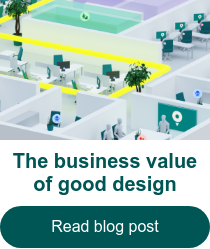You have an event management solution, and you are wondering whether or not to add an indoor map because, well, it seems like the new trend. But is it a must-have or just a nice-to-have?
The short answer is that it is a must-have. Why? Well, for starters, your users expect it. And secondly, it is your secret weapon to outshine the competition, supercharge your solution, and turbocharge your business.
But, before we delve into the business benefits of adding an indoor map to your solution, let us zoom in on your users and their expectations.
When all signs lead to dead ends
(If you do not want to know how the lack of a map can transform a good experience into a bad one in less than four hours, skip this part and jump right into the ‘Business benefits of an indoor map’.)
I want to share a real-life story with you that happened around six months ago at an event in Paris. The venue, a spacious convention center, hosted numerous events simultaneously, separated by heavy, blue curtains. These curtains initially created an intimate atmosphere, tempting attendees to wander along booths with a warm cup of coffee from PAUL in hand. But, as the hours passed, those same curtains transformed from inviting to irritating.
It was not the curtains themselves that were the problem, though; it was the lack of a map. Without any clue where to find the restrooms, people started to look for signs to locate them. And there were plenty of restroom signs hanging high in the air as if they wanted to be seen from space. The problem was that every time you followed one of the signs, you eventually found yourself face-to-face with the blue curtain that turned out to conceal a temporary wall.
Now, you might be thinking, 'What on earth does this have to do with my event management platform?'
Is your app filled with valuable, useless information?
Well, it is the job of event organizers to ensure that attendees can easily find both restrooms and maps. However, when people are using your application at events, they do not usually differentiate between your app and the event organizers. They expect your app to provide them with all the essential information, including a map.
Back in Paris, attendees were not irritated because there were no physical maps available. Who wants to search for a map just to locate a restroom, right? Instead, what really got on their nerves was that the app failed to provide the information they needed:
- It had a list of exhibitors but no map to show where to find them.
- It had a schedule, but there was no map to guide attendees to different stages.
- It listed coffee shops and restaurants but left users guessing about their locations.
- It featured a list of amenities, but it left people in the dark about where to find them.
So much valuable information, yet it is made useless due to the app's absence of a map. And what was the result? A poor user experience...
If your application does not meet your users' expectations, they will stop using it. A digital indoor map could easily have solved the wayfinding problems in Paris, and users would have been wowed by the application instead of annoyed.
The business benefits of an indoor map
Indoor maps come in all shapes and sizes. From nice-looking CAD drawings to image-based static maps to dynamic mapping platforms.
Static maps are cheap and easy to implement, but they do not enable the features below. An indoor mapping platform requires more development to integrate, but in return, it enables a range of integration opportunities, upsell opportunities, and new revenue streams.
3 Indoor mapping features that will supercharge your solution:
#1: 3D maps
If you want to outshine your competitors, your design has to be flawless. Design compels us to pay more than $999 for an iPhone versus a cheaper alternative, so investing in design is a must if you want your solution to be among the best. With an indoor mapping platform, you can get stunning 3D maps that will wow your customers and take user experience through the roof.
#2: Upselling opportunities
With an indoor mapping platform integrated into your solution, you can offer your clients new upselling opportunities through branding. This means that your clients can offer sponsors and exhibitors more visibility by allowing them to add their logo or 3D booth visuals to the map through an additional fee.
#3: Easy booking
Indoor mapping platforms easily integrate with third-party systems such as booking solutions. This means that by adding an indoor mapping platform to your solution, you enable your customers to integrate the map with their room booking system and thereby enable exhibitors to easily book meeting rooms through the map before and during events.
Turbocharge your business
Indoor maps may not be widely adopted in event management platforms yet but they will be. The indoor location market size is worth approximately $10.9 billion, according to Markets & Markets, but it is poised to hit $29.8 billion in 2028. The more widely adopted indoor maps become, the more your customers and end-users will also expect it from your application.
An indoor mapping platform scales with your business no matter how much it grows and how much your customers grow. Convention centers make thousands of floor plan changes while preparing for new events. An indoor mapping platform automatically updates your customers’ maps as they make floor plan changes in their system and the changes are reflected on the map almost instantly. This means that they always have up-to-date maps and you never have to worry about the accuracy of your solution.
If you liked this blog post, maybe you will also like the blog post below about the business value of good design.

.png?width=220&name=Google_Premier_Partner%20(1).png)